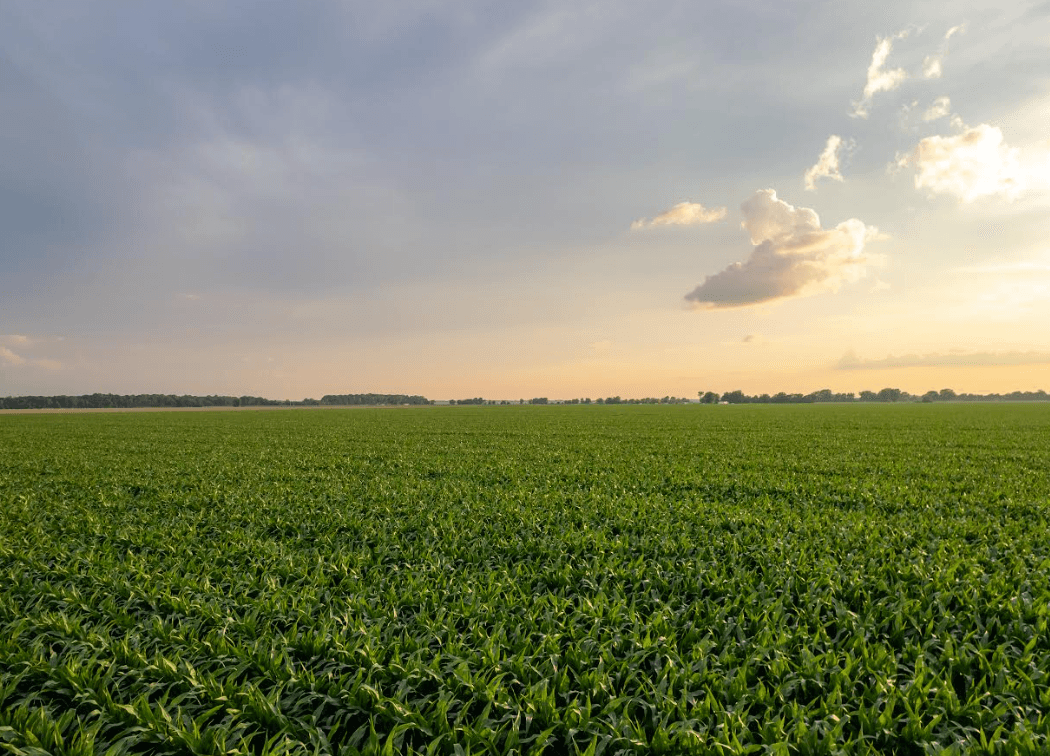Investing in Row Crops vs. Permanent Crops
16 September, 2025

Why LandFund Partners Focuses on Row Crop Farmland in the Mid-South
Farmland is known for its historical performance as a hedge against inflation and its long-term stability.
Investing in farmland has become an increasingly attractive way for individuals and institutions to diversify portfolios with a tangible, income-producing asset. There are different types of farmland in the United States, and two categories that stand out as having clearly different investment return characteristics: row crop farmland and permanent crop farmland.
Understanding Row Crops vs. Permanent Crops Farmland
Row Crop Farmland
Row crop farmland is land used to grow annual or rotational crops that are planted, harvested, and replanted each season. Common examples include corn, soybeans, cotton, wheat, rice, and other grains or fiber crops. The standard harvest for these crops is 6-12 month cycles. Because the land is replanted each year, it allows flexibility in rotation, crop selection, and soil management. This gives the farmer the option to plant different crops depending on changing market demand and profitability.
Owners of row crop farmland typically earn annual income through cash-rent or crop-rent agreements in which the farmer pays the landowner. Cash leases have less risk than crop leases, which provide the landowner participation in the actual crop yield or profitability of the farm operations. Row crop leases tend to produce lower cash flows than permanent crop operations, but are highly reliable and predictable as the farmer has the ability to switch crops annually and also benefits from major government support payments in down years.
Permanent Crop Farmland
Permanent crop farmland is farmed with perennial plantings that remain in place for many years, for example, orchards (apples, citrus, nuts), vineyards, olives, etc. These crops typically take 3-6 years from the initial planting to produce and can even reach 10 years before full maturity. Because these plants are not replanted each year, they require multi-year establishment phases before reaching commercial yield.
With permanent crops, the owner (or farm operator) bears more direct exposure to agricultural performance, crop-specific risks (disease, pests, varietal risk), and capital replacement cycles (aging trees, replanting). That added complexity and risk can translate to higher upside in good years, but also steeper downside in adverse years.
Returns in Farmland Investing: Cash Flow + Appreciation
When assessing farmland investments, whether row crop or permanent crop, it’s helpful to break down returns into two components since farmland returns are a combination of stable income and long-term capital growth:
1. Cash Flow/Yield
- For row crop farmland under cash lease, the cash flow is stable, driven by annual rent agreements.
- For permanent crop farmland, cash yields can be higher once full production is reached, but during the establishment period, the property may generate minimal or even negative cash flows.
2. Capital Appreciation
- Over long periods, the increase in land value often constitutes a large portion of total return in farmland investments.
- Because row crop properties generally don’t carry depreciable biological assets (trees/vines), appreciation of the land itself tends to be simpler to model and less exposed to capital replacement pressures.
Why LandFund Partners Focuses Solely on Row Crop Farmland Investments
LandFund Partners made the strategic choice to focus their acquisitions on row crop farmland in the Mid-South region of the United States. Here is why:
1. Crop Diversity
The region has multiple soil types and climate flexibility. This provides row crop farmers with more choices of which commodity to plant annually, increasing the potential for profitability and reducing risk across changing market conditions.
2. Relative Value
High-quality Mid-South row crop farmland can be purchased for roughly half the price of high-quality Midwest row crop farmland.
3. Reliable Ground Water
Over 300 years of steady and reliable water from the Mississippi River Alluvial Aquifer across most of the region supports long-term sustainability, and strong crop yields even during years with drought conditions when the right irrigation infrastructure is in place.
4. Regional Presence
Our in-house farm management team and fund leaders have strong local relationships in the Mid-South. This helps to support access to off-market deal flow for high-quality farmland in the region.
Historical Performance of U.S. Row Crop Farmland
U.S. row crop farmland has generated double-digit annual returns over the past 30 years with significantly lower volatility than equities and other asset classes.
Data Sources and Notes: U.S. Row Crop Farmland represented by NCREIF.org Annual Cropland Index, Timberland, Office and Multifamily sourced from NCREIF.org, NYUStern.edu Aswath Damodaran data sets utilized. S&P 500 inclusive of dividends. Past performance is no guarantee of future results.
U.S. row crop farmland can help investors diversify their portfolio because its returns are historically not correlated with stocks, bonds, or other real estate.
Why Invest with LandFund Partners?
Since our firm was founded in 2013, LandFund Partners has successfully deployed capital across seven funds and over 50 farmland investments in the Mid-South region. Our disciplined approach has delivered consistent returns, capital preservation, and enhanced asset value through proactive management. We lease the land to farmers in return for cash rent payments, providing stable income while maintaining long-term ownership. Investors in LFP Soil Enrichment Fund (“SEF”) receive an annual distribution, while participating in the long-term upside of farmland asset values.
Start the Conversation
LandFund Partners acquires and manages premium farmland across the Mid-South United States. We give institutional and accredited investors direct access to the asset class through carefully managed funds.
To learn more about investing in row crop farmland as an alternative asset:
- Why invest in Mid-South Farmland? Download the LFP Mid-South Farmland White Paper
- See LFP’s proven track record: LFP Track Record
- Get in touch with our team: Interest Form Fill
- Newsletter Signup: LFP Newsletter
- Email: [email protected]
